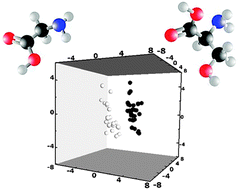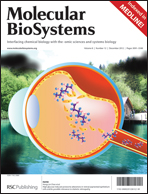Targeted metabolomics identifies perturbations in amino acid metabolism that sub-classify patients with COPD†
Abstract
Background: COPD, a leading cause of mortality is currently assessed by spirometry (forced expiratory volume in 1 second, FEV1). However FEV1 does not correlate with patient mortality. ECLIPSE (Evaluation of Chronic obstructive pulmonary disease to Longitudinally Identify Predictive Surrogate Endpoints) aims to identify biomarkers that correlate with clinically relevant COPD subtypes, and to assess how these may predict disease progression. New methods were developed and validated to evaluate small molecules as potential diagnostic tools in patients with COPD, COPD related cachexia and cancer related cachexia. Methods and findings: quantitative LC-MS/MS was developed to measure 34 amino acids and dipeptides for stratification of patient groups. Subsets of the ECLIPSE patients were used to assess biomarkers of lung obstruction; GOLD IV (n = 30) versus control (n = 30); emphysema (n = 38) versus airways disease (n = 21) and cachexia (n = 30) versus normal body mass index (n = 30). Serum from cachexic (n = 7) and non-cachexic (n = 5) pancreatic cancer patients were included as controls. Targeted LC-MS/MS distinguished GOLD IV patients from controls, patients with and without emphysema and patients with and without cachexia. Glutamine, aspartate and arginine were significantly increased (p < 0.05; FDR adjustment α < 0.1) in cachexia, emphysema and GOLD IV patients and aminoadipate was decreased. Several amino acid concentrations were significantly altered in patients with COPD but not patients with pancreatic cancer (serine, sarcosine, tryptophan, BCAAs and 3-methylhistdine). Increased γ-aminobutyrate (GABA, p < 0.01) levels were specific to cachexia in patients with pancreatic cancer. β-aminoisobutyrate, 1-methylhistidine and asparagine (p < 0.05) were common across the patients with cachexia from both the COPD and pancreatic cancer cohorts. Conclusion: these results demonstrate that a metabolomic fingerprint has potential to stratify patients for the treatment of COPD and may provide a means of assessing response to therapy. GOLD IV patients were distinguished from smoker control subjects, patients with emphysema were distinguished from those without emphysema and COPD patients displaying cachexia were distinguished from those not displaying cachexia. General markers of cachexia were discovered reflecting both COPD- and pancreatic cancer-related cachexia (increased glutamine, aspartate, arginine, and asparagine and decreased aminoadipate, β-aminoisobutyrate and 1-methylhistidine). Metabolomic biomarkers, particularly altered levels of GABA, could be exploited as a way of monitoring treatment efficacy and tumour recurrence for patients with pancreatic cancer experiencing cachexia.


 Please wait while we load your content...
Please wait while we load your content...